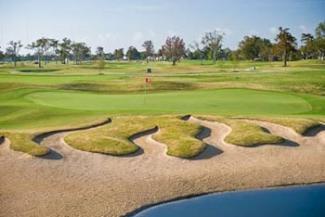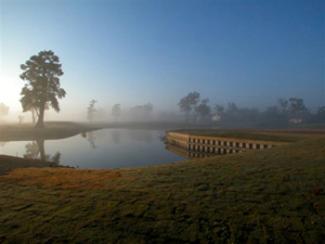Featured Golf News
Two Daily-Fee Courses Helping Golf Resurgence in New Orleans
The toll taken on the city of New Orleans and the surrounding communities by Hurricane Katrina and, a month later, Hurricane Rita was not limited to the destruction of homes, uprooting of families and creation of severe doubt about the federal government's ability to handle the devastation in the aftermath of such storms.

Flames Lap toward the 18th green
at Lakewood GC in New Orleans
While miniscule when compared to the overall impact on the region, the storms took their toll on the region's golf industry, either by the damage caused by the storms, the flight of citizens and golfers from the area, and the diversion of resources that would have been available to golf course operators to more pressing concerns.
Two daily-fee courses, Lakewood Golf Club and 27-hole Stonebridge Golf Club - both across the Mississippi River on the West Bank in Gretna, have helped lead the resurgence of golf in the "Big Easy." Both boast playable routings and rely on plenty of twists and turns - but fewer trees than before the storms - to spice up the relatively flat land in this part of Louisiana.
We played both courses recently and are happy to report that most golfers here have moved on from the hardships caused by the hurricanes, at least to a point where these tracks now provide pleasure and escape, two objectives golf courses anywhere and under any circumstances should aspire.

Lakewood Golf Club
Happy 50th, Lakewood!
Founded as Lakewood Country Club in 1961 and serving as the host of New Orleans' PGA Tour event 26 times, Lakewood Golf Club is celebrating its 50th anniversary this year. After a multi-million-dollar renovation, the course is now a lot different than the one designed by Robert Bruce Harris, an adherent of the "garden school" of golf architecture. This is a great track with some cool features and - at 7,002 yards - a good test of golf.
Lakewood was on the verge of bankruptcy when the New Orleans Firefighters Pension Fund purchased the property in May 2003 for $6 million. The private club was closed and the facility opened to the public. There were grand plans for the site, including the development of an upscale resort that would include golf villas, a four-star luxury hotel and condominiums.
Those lavish ideas were sidetracked by the dual hurricanes, but the course - with a fabulous new set of holes designed by Ron Garl - preserved the character of the original layout while upgrading it with creative bunkering, modernized fairway contouring and updated tee boxes and greens.

The Fleur de lis Bunker on No. 1 at Lakewood GC
Lakewood is nestled among beautiful Louisiana cypress and oak trees. Garl's work features distinctive bunkers, including four red-sand-filled "flaming" hazards (three of which are on the 444-yard par-4 18th hole), one formed to resemble a Fleur de lis and another in the shape of a fireman's seal, all tributes to Louisiana and the firemen-owners of the course. In addition, Indiana woodcarver Dayle Lewis transformed several trees that were damaged by Katrina into works of art.
The course itself is commendable, especially it's wonderful collection of par-4s (handicap Nos. 1-4 are two-shotters, each at least 439 yards in length) and short par-3s (none longer than 189 yards).
Players will love the look of the snaking 569-yard, par-5 first hole - with trees on the right and water left - while getting a chuckle at the sight of the flaming bunkers (which are likely not in play) at the 378-yard par-4 fifth.
The 519-yard, par-5 13th can be reached in two if avoiding the (traditional) bunker that crosses the fairway 50 yards from the green. Long-hitters may also want to take a shot at the green on the 385-yard, par-4 14th, which turns hard from left to right.
Lakewood's final two holes are noteworthy - one for water and the other for fire, or at least the reference of it. The 17th is a 160-yard par-3 played over a pond to a green surrounded by water on three sides. The par-4 closer involves an into-the-wind 444 yards and sports three of Garl's flaming bunkers and a Lewis woodcarving of an angel hovering over a fireman carrying a baby.
From the tips, Lakewood Golf Club is rated 73.3 with a Slope of 132. For more information, visit http://www.lakewoodgolf.com.

New Orleans' Stonebridge Golf Club
Stonebridge Showcases the Crescent City's Canals & Bayous
After the storms battered New Orleans, Stonebridge's management worked tirelessly to quickly get their course back into playing shape to give storm-stunned residents a much-needed recreational outlet. The course - set among hundreds of homes - was battered by the wind and pelted with roof shingles blown off by the storms, but it didn't get much flooding.
These days, the main thing golfers worry about is the track's 100-plus bunkers that are strategically strewn about. Water - in the form of 28 lakes, ponds, canals and bayous - enter play on nearly every hole. The course occupies mostly flat terrain and is very open on the interior, with a few trees to deal with. Forced carries are also at a minimum.
Stonebridge Golf Club opened in 1984 and was renovated by John Robinson 20 years later. The par-72 course stretches 7,031 yards, where it carries a rating of 74.3 and a 135 Slope.
The massive 467-yard, par-4 fourth has eight bunkers in various spots both sides of the fairway, and the 462-yard eighth has two deep 100-yard-long sand hazards on either side.

Hole Nos. 1 & 9 at Stonebridge Golf Club
The back nine's stoutest tests are its par-4s, including the 422-yard 13th and the 470-yard 15th. No. 14 is a short but stern par-3 over water. Players will also be challenged by the 590-yard, par-5 10th.
It's "other nine," which plays to a par of 35 and at 3,047 yards, compliments the main course but is more than an executive track. Some of the toughest holes on Nos. 19-27 include its two par-5s, the 542-yard 23rd (which turns left to right and features a pond that must be carried on the approach), and the 521-yard 26th, a straightaway hole with four bunkers guarding the green.
With six sets of tees, holes named after jazz greats Louis Armstrong, Pete Fountain and Al Hirt and plenty of chances to see reptiles and waterfowl, Stonebridge characterizes the uniqueness of the New Orleans golf experience.
For more information, visit http://www.stonebridgegolfofno.com.
Steve Habel is one of Cybergolf's world correspondents, contributing news stories, features, equipment and book reviews and personality profiles from his base in Central Texas. He is also works as a contributing editor for Horns Illustrated magazine, a publication focusing on University of Texas sports, covers the Longhorns for CBS Sports, is regional editor for Texas Golfer magazine and files stories for Golf Oklahoma magazine, Texas Links magazines and Golfers Guide. Habel's main blog (www.shotoverthegreen.blogspot.com) features news on golf and the Longhorns, and another (www.checkinginandplayingthrough.blogspot.com) chronicles his many travels, on which he has played more than 350 golf courses since 2009. Habel is a member of the Golf Writers Association of America and the Texas Golf Writers Association.
Story Options
 |
Print this Story |
